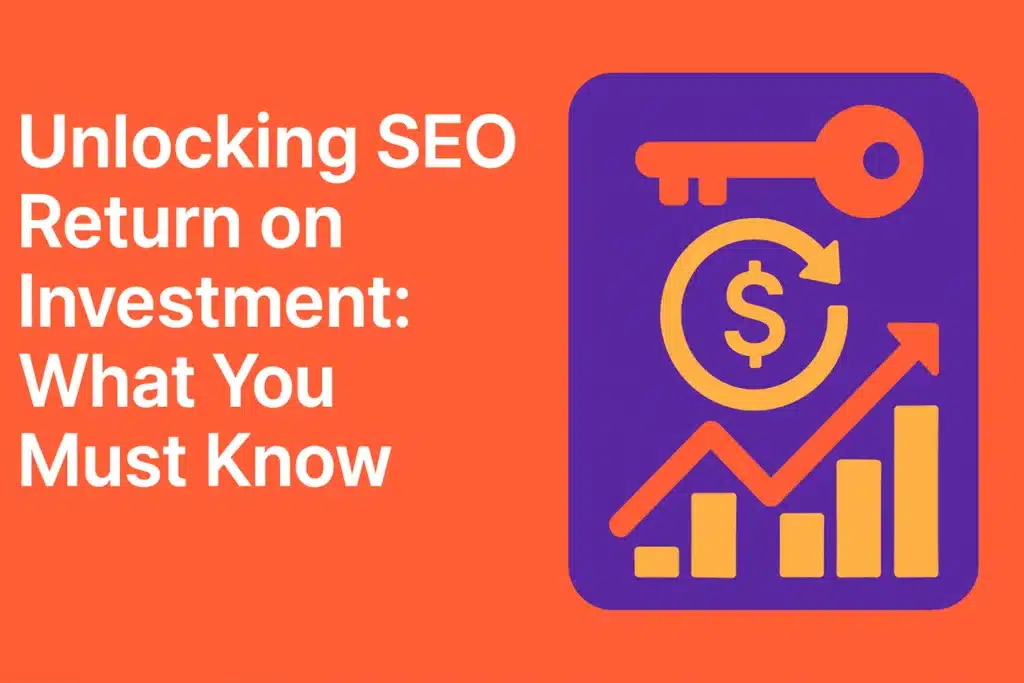Many marketers want to see real gains from their search efforts but feel uncertain how to assess them. SEO return on investment shows the actual impact of organic tactics on profits. It highlights whether your website’s visibility converts into meaningful conversions, revenue, and enduring brand growth. By focusing on the right metrics and improving over time, you can drive consistent results that improve both traffic and trust.
Paid ads or email promotions often grab attention, yet SEO holds unique potential. This content explores key concepts, from grasping why continued improvement helps sustain leads to measuring success through relevant tools. Readers seeking practical methods to measure SEO performance or calculate SEO results will discover findings to guide ongoing plans and realize long-term value.
What is SEO Return on Investment?
SEO return on investment measures how your organic search efforts convert into profit. It compares revenue gains against the costs of improving your site. By tracking conversions, traffic, and lead quality, you verify whether your SEO method provides real results that justify the dedicated time, energy, and spending in marketing efforts.
How SEO ROI compares to paid channels
Organic listings obtain 53.3% of website traffic, while paid placements add faster visibility. SEO often lasts longer than ads but needs time. Click fraud threatens PPC budgets, costing marketers. Both channels can support each other for bigger returns (HigherVisibility).
Key factors influencing SEO ROI
Technical improvement, on-page relevance, and content quality form long-term results. Link building also increases domain strength and trust. Clear tracking of KPIs, from traffic to leads, affects how you measure SEO performance and prove profits over time.
1. Drive Long-Term Website Growth
SEO ROI goes beyond quick traffic surges. Steady improvements and reliable content can keep your site relevant. Over time, each update strengthens rankings, increases visibility and revenue, and improves customer interaction. A long-term method promotes continued growth that often surpasses short-lived campaigns, highlighting the real value of consistent search efforts.
How sustained SEO performance boosts traffic
Regular page improvements with keyword focusing on create continuous traffic. Search engines raise sites that provide material. Continued efforts add trust, helping your pages climb in rankings. This process creates visitors who discover and revisit your brand organically.
Why consistent content pays off later
Blogging twice per week helped one creator surpass 32,000 monthly views and build a multi-million business (Paige Brunton). Steady production shows expertise and offers more chances to engage searchers over time. That method led to visitor growth.
2. Reduce Marketing Costs Over Time
SEO can trim marketing expenses by lowering dependence on constant ads. Once pages rank, clicks arrive without extra pay-per-click charges. This method lowers customer getting costs and eases budget pressure long term. Careful site improvement guarantees stable traffic streams that eliminate repeated spending spikes. This emphasizes SEO ROI for results.
How effective SEO strategy lowers CAC
Paid ads charge per click, raising getting costs. SEO creates consistent traffic, avoiding each-click fees. Research shows 89% of leaders expect organic search revenue to rise (Lumar). This shift reduces CAC and helps businesses use budgets well.
Why organic traffic costs less than paid ads
Organic traffic can reach a 748% ROI versus 36% for paid campaigns (First Page Sage). Once you get rankings, you avoid recurring costly ad spend. This setup gives better margins while maintaining progress without ongoing budget distribution.
3. Attract High-Intent Traffic for Better Leads
SEO helps you get visitors who are already researching answers. These people often convert faster because they need fewer convincing steps. Focusing on commercial keywords concentrates on those closer to buying. This method raises lead quality and supports reliable overall revenue, enhancing search-driven strategies. It often increases SEO return on investment.
Why SEO attracts users actively looking
SEO gets people who look for answers, so they arrive ready to convert. It provides one of the highest ROI rates for lead generation (OneDot Media). By focusing on relevant keywords, brands meet eager users who require fewer prompts.
How user search intent boosts lead quality
Aligning with user intent raises conversions and reduces bounce rates. One practice reached #1 for ’emergency dentist in Philadelphia’ and attracted local leads (Search Engine Journal). Delivering answers fast raises trust, bringing higher-quality potentials ready to take action.
4. Increase Brand Trust and Visibility
Search rankings act like approvals for your brand. When top positions show up repeatedly, users see trust. A recognized domain often draws more clicks, which support brand loyalty and recognition. Consistent performance in organic results convinces new visitors that your content can meet their needs and create genuine lasting confidence.
How SEO rankings impact credibility
Regularly ranking high raises brand awareness, which affects trust. Most businesses notice stronger standing in three to six months. Tools like Google Analytics help track improvements in organic traffic and interaction (Content Whale). SEO builds further recognition.
Why authority matters in search engine results
Authority shows that you know your field. Search engines prefer brands with proven knowledge, which can earn higher rankings (Mailchimp). Building trust encourages repeat business and positive word-of-mouth. A recognized authority usually maintains stronger visibility than competitors.
5. Gain Measurable Data to Shape Strategy
SEO shows measurable metrics, from clicks to conversions. You see which keywords drive results and which pages attract leads. By checking organic traffic trends and user activity, marketers improve tactics to enhance results. Data-backed findings remove guesswork, guiding adjustments for better positioning and stronger SEO ROI while maximizing overall profits.
How to measure SEO performance using KPIs
A key performance indicator monitors progress toward business targets (Klipfolio). Marketers watch organic traffic, leads, and revenue from search. Google Analytics offers data on eCommerce or conversions. Google Search Console shows queries and click-through rates for insight.
Use tools to calculate SEO results efficiently
Platforms like Google Analytics, Semrush, or Ahrefs monitor organic traffic, keyword ranks, and conversions. Google Analytics identifies getting channels easily (Backlinko). Checking these metrics shows what works and where to shift for results and better SEO ROI.
6. Achieve Better ROI Than Most Campaign Types
Organic positions can deliver bigger returns than many campaigns. Though email marketing is useful, SEO often drives recurring visits without direct mailing costs. PPC can produce quick wins, but organic rankings endure. By combining traffic over time, SEO ensures strong returns and loyal audience interaction. This advantage emphasizes SEO success.
Comparison of SEO ROI with email and PPC
SEO often beats both email and PPC in long-term profit gains (HigherVisibility). Email requires maintenance of subscriber lists, while PPC suffers from ad fraud risk. Organic rankings often remain stable, delivering recurring benefits with fewer ongoing fees.
SEO effectiveness analysis for campaigns
By measuring results against marketing spend, businesses learn which efforts drive profit. SEO’s low cost, combined with ranking benefits, can beat other tactics (HigherVisibility). Data from clicks and conversions helps improve plans for more return on investment.
Conclusion
Solid SEO delivers clear gains that stretch beyond quick wins. By earning high-intent traffic without constant ad spending, businesses experience reliable growth and reduced costs. Strong rankings improve brand trust and help attract loyal visitors. Tracking data through platforms like Google Analytics or Search Console guides planned changes, boosting conversions and strengthening the value of seo return on investment. With a patient approach, SEO’s combined effect multiplies results over time. This path combines lower getting costs, stronger customer trust, and lasting visibility that supports expansion. It emphasizes measure seo performance’s potential.
FAQs
Frequent questions often come up about checking SEO returns, frequency of data checks, and reliable tools. Many wonder if these results can be predicted or guaranteed, and how soon they appear. Others question SEO’s role for smaller ventures targeting local customers.
What is the best way to measure SEO return on investment?
How often should you calculate SEO performance metrics?
Which tools help analyze SEO effectiveness?
Can SEO ROI be guaranteed or predicted?
How long does it take to see SEO ROI results?
Is SEO ROI important for small or local businesses?

Ridam Khare is an SEO strategist with 7+ years of experience specializing in AI-driven content creation. He helps businesses scale high-quality blogs that rank, engage, and convert.



